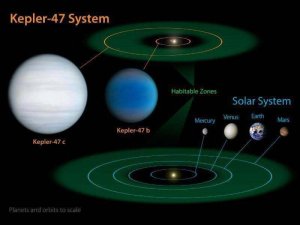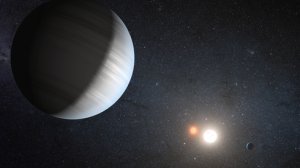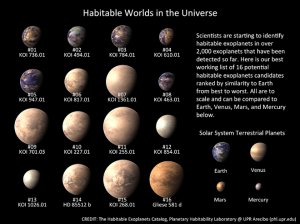

If you think it’s hard to be in a stable orbit around one star, think of how hard it must be to maintain an orbit around two. Binary star systems are the most common type of star system we have found. For quite some time, astronomers have known of exoplanets orbiting binary star systems (these planets are called cicumbinary planets). Recently however, in a binary star system 4,900 light-years from Earth, astronomers have discovered two planets in a stable orbit. This is exciting because it tells us that multiple planets can form and remain in a stable orbit around binary systems…ultimately opening the way for the possibility of the existence of more planets (and, potentially, habitable worlds – how would you like that sunrise?).
The Kepler-47 system is a binary star system where the stars eclipse every 7.5 days. One of these stars is comparable to our sun; the other is about one-third of our sun’s mass. The two planets, Kepler 47b and 47c, are transiting planets (meaning, the planets pass in front of the star relative to Earth). Detecting a transiting planet around a binary system is tricky to say the least. Jerome Orosz, an astronomy professor at San Diego State University explains, “In contrast to a single planet orbiting a single star, the planet in a circumbinary system must transit a ‘moving target.’ As a consequence, time intervals between the transits and their durations can vary substantially, sometimes short, other times long. The intervals were the telltale sign these planets are in circumbinary orbits.”
So, what do we know about these two planets?

Kepler-47b has a semimajor axis of 0.3 AU and an orbital period of about 50 earth days. The planet is a gas giant and has an estimated mass 2.7 times Jupiter’s. Although it is dense enough to be a brown dwarf, the planet itself is too small to be considered one.
Kepler-47c, on the other hand, has a semimajor axis of nearly 1 AU (0.989 AU) and has an orbital period of 303 Earth-days. Also a gas giant, this planet has an estimated mass of 17 Jupiter masses and has a radius of about 0.4 Jupiter. The planet is dense enough to be considered a brown dwarf, and it orbits within the binary-system’s habitable zone – not that it does our type of life any good since the environment would kill us.

Even though these planets closely resemble our favorite binary-star planet of Tatooine, the environment on these planets is hostile enough to make a summer vacation a very bad idea. At least we have a ‘proof of concept’ for multiple planets orbiting a binary system. I anticipate this is only the first such system of many to follow.